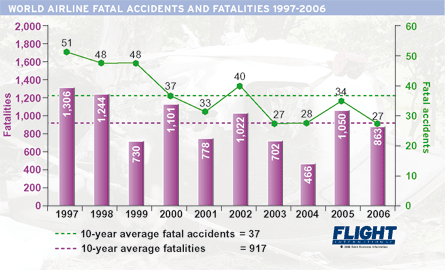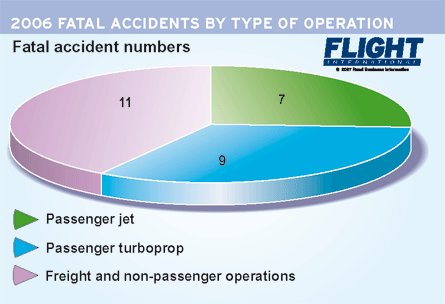It is getting safer to fly, but the record in some parts of the world remains a challenge. We assess last year's figures and the prospects for 2007
A fatal Boeing 737-400 accident in Indonesia on 1 January may have got the new year off to an inauspicious start, but if trends confirmed in 2006 are sustained, airline safety has a good chance of improving in 2007.
The rate of improvement, however, is slowing down as the industry takes on the principal remaining major safety task - that of helping to raise technical and operational standards in the world's poorer economies. Improvement in the more mature economies is becoming more a matter of refining strategies rather than just working on basic principles.
|
|---|
S7 Airlines disputes the findings of CIS investigative agency MAK into its Airbus A310 overrun at Irkutsk in July - a quarrel that could lead to MAK's role being changed |
Airline fatal accident numbers declined last year to 27 - equalling the lowest annual figure for 10 years despite traffic growth. Flight International had recorded 34 fatal accidents for 2005, which now shows as a small upward spike in the graph for the decade (see chart).
The 2006 figure of 27 fatal accidents has restored the clear overall safety improvement trend for the past 10 years, comparing favourably with the decade annual average, which currently stands at 37 fatal accidents. Only seven of the fatal accidents last year involved passenger jet operations (see pie charts).
Total crew and passenger fatalities in the past 12 months, at 863, were below the annual average for the decade (917). That may sound good compared with 2005's total of 1,050, but the fatalities figure has been lower in four of the years between 1997 and 2004 (inclusive), the smallest number being 466 in 2004.
At least five, and possibly seven, of the fatal accidents were controlled flight into terrain (CFIT). The final verdict will depend on facts yet to be determined by the investigations. None of the aircraft involved were fitted with terrain awareness warning systems (TAWS). The previous year there were seven fatal CFIT accidents. Director of technical programmes at the Flight Safety Foundation Jim Burin points out that there has only ever been one year - 2004 - in which there were no CFIT accidents involving commercial jet operations, so this killer is still undefeated despite efforts over the past 15 years to train pilots and airlines to recognise and deal with CFIT risk, and to persuade carriers to equip aircraft with TAWS.
Unnerving event
The Armavia Airbus A320 crash in the Black Sea offshore from Sochi in Russia was an unnerving event because it is so alike two other recent fatal jet accidents, and it occurred during a manoeuvre that is not essentially demanding. The manoeuvre is a climbing turn at night with no external visual horizon. Just as in the case of the August 2000 Gulf Air A320 crash offshore from Bahrain, this accident proved that pilots can lose control of even a flight-envelope-protected aircraft if they lose situational awareness, particularly while flying manually.
Early reports from the CIS Interstate Aviation Committee (MAK) investigators say the A320's flight data recorder indicates there were no detected problems with the aircraft or its engines. In both the Sochi and the Bahrain accidents the crew had abandoned their approach and were carrying out climbing turns at night over water but the climbing turns became descending turns without the pilots being aware of what was happening. In the 2000 accident, the Bahraini investigators also found no technical faults.

Meanwhile, the report on the 2004 Flash Airlines Boeing 737-300 accident confirmed that the captain, also carrying out a climbing turn at night over the sea, lost control because of disorientation. The report pleads that there is no clear proof of exactly what happened, but it suggests the captain became disorientated as a result of distraction by minor faults, which would make them the primary cause and the disorientation a contributory cause. The Egyptian civil aviation authority investigation team, led by Capt Shaker Kelada, reported: "No conclusive evidence could be found from the findings gathered...to determine a probable cause."
But both the US National Transportation Safety Board and the French investigation board BEA, in comments appended to the report, say there is no evidence of technical failure that could have led to the upset. They maintain that the cockpit voice recorder (CVR) transcript and the flight profile indicate that the captain - the pilot flying - had become spatially disorientated during the night departure.
Fatal illusion
Burin points out that in the Gulf Air accident the aircraft was under control at all times according to the report, but the pilot was disorientated partially by "somonographic illusion". This is the sensation - caused by the acceleration during go-around - that the aircraft was pitching up more than commanded, to which the captain reacted with a nose-down stick input that led to the crash into the sea. Burin says that it will be "interesting to see if the same dynamics were present with Armavia".
The S7 Airlines - formerly Sibir - Airbus A310-300 fatal overrun at Irkutsk in July has generated controversy that may influence the future of the CIS's main accident investigation agency, the MAK. The report (see accident tables) says the captain and co-pilot mishandled the throttles on landing, but S7 Airlines is vehemently disputing the conclusions, insisting: "We cannot recognise them as complete and comprehensive." It adds: "Investigators have presented a conventional version of events convenient for themselves. It fully ignores such factors as technical condition of the runway and aircraft as well as weather conditions during landing."
Since its inception in 1991 as a joint agency for 12 former Soviet Union countries, the MAK has been in charge of certificating aircraft and airport safety throughout the CIS, but it is also the accident investigation agency. This multilateral mandate does not comply with International Civil Aviation Organisation standards and a transport ministry official has confirmed: "We have been requested by the Russian president to look into the matter, and are acting on that order."
Meanwhile, in a series of events that damages the credibility of the US Federal Aviation Administration's campaign for improved runway safety, the USA saw one fatal and four non-fatal runway-related events last year. The fatal accident took place on 27 August when a Comair Bombardier CRJ100ER took off from the wrong runway at Kentucky's Blue Grass airport (see accident tables) and overran into trees because the runway was too short. Meanwhile, at Chicago O'Hare airport a United Airlines 737-300 took off from runway 27L as cleared, and flew just over the top of an Atlas Air 747 freighter that was landing on the crossing runway 14R. The FAA says it looks as if there was an ATC mistake.
Then there were two other non-fatal incidents, one in which a Continental Airlines 757 took off from the wrong runway and the other in which a 757 from the same carrier landed on the taxiway beside its cleared landing runway. Finally a US air force Boeing KC-135 was destroyed - with no loss of life on either aircraft - by a Kyrgystan Airways Tupolev T-154 that had been cleared to take off at Manas airport in Kyrgystan before the KC-135 had cleared the runway. The Tu-154 lost 2m (6ft) of its right wingtip, but successfully took off and made a circuit to land back.
Meanwhile, Eurocontrol continues to express regret about the lack of voluntary reporting of runway incursion incidents. The agency argues that assembling data about such events is the only way to understand the risk fully so as to create strategies to defeat the problem, and says one of the reasons controllers and pilots are not prepared to report is that most countries have a legislature that criminally prosecutes mistakes, even unintentional ones that are voluntarily reported.
There were numerous cases of on-board fires last year, although none were fatal. The UK Air Accidents Investigation Branch says aviation safety agencies on both sides of the Atlantic are moving too slowly on improving electrical wiring safety in older aircraft. In its first progress report to the European Aviation Safety Agency on the status of follow-up actions recommended in accident/incident reports, it calls on both the EASA and the FAA to "expedite a requirement for the replacement of existing thermal/mechanical type circuit breakers [CB] by arc fault circuit breakers".
Challenges
Despite remaining challenges, the International Air Transport Association's director of programmes implementation Mike O'Brien has recently pointed out that, at 1 December, last year looked set to be the safest year ever with a global average rate of 0.65 hull losses per million sectors and an IATA member carrier hull-loss rate of 0.29 for the same period. There was one jet hull loss, but no fatal accidents in December, so the overall verdict for 2006 remains good.


Source: Flight International




















